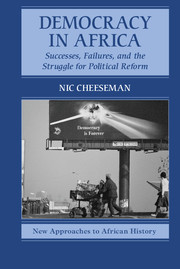Book contents
- Frontmatter
- Dedication
- Epigraph
- Contents
- LIST OF FIGURES
- LIST OF TABLES
- LIST OF ACRONYMS
- ACKNOWLEDGEMENTS
- Introduction: Democratization Against the Odds
- 1 Fragments of Democracy: Participation and Control in Authoritarian Africa
- 2 Cultures of Resistance: Civil Society and the Limits of Power
- 3 The Second Liberation: Economic Decline, the End of the Cold War, and the Struggle for Democracy
- 4 Exporting Elections: International Donors and the Era of Democratic Dependency
- 5 Subverting Democracy: The Advantages of Incumbency and the Politics of Violence
- 6 The Democratic Dividend: Political Competition, Populism, and Public Policy
- Conclusion: Designing Democracy to Manage Diversity and Distrust
- APPENDIX 1 The Fate of Africa's Democratic Experiments 1989–2014
- APPENDIX 1 THE FATE OF AFRICA'S DEMOCRATIC EXPERIMENTS 1989–2014
- INDEX
- References
Conclusion: Designing Democracy to Manage Diversity and Distrust
Published online by Cambridge University Press: 05 May 2015
- Frontmatter
- Dedication
- Epigraph
- Contents
- LIST OF FIGURES
- LIST OF TABLES
- LIST OF ACRONYMS
- ACKNOWLEDGEMENTS
- Introduction: Democratization Against the Odds
- 1 Fragments of Democracy: Participation and Control in Authoritarian Africa
- 2 Cultures of Resistance: Civil Society and the Limits of Power
- 3 The Second Liberation: Economic Decline, the End of the Cold War, and the Struggle for Democracy
- 4 Exporting Elections: International Donors and the Era of Democratic Dependency
- 5 Subverting Democracy: The Advantages of Incumbency and the Politics of Violence
- 6 The Democratic Dividend: Political Competition, Populism, and Public Policy
- Conclusion: Designing Democracy to Manage Diversity and Distrust
- APPENDIX 1 The Fate of Africa's Democratic Experiments 1989–2014
- APPENDIX 1 THE FATE OF AFRICA'S DEMOCRATIC EXPERIMENTS 1989–2014
- INDEX
- References
Summary
This book has documented the great variety of pathways through which African countries have moved toward, and away from, democracy. It started by highlighting some of the biggest challenges facing the consolidation of democracy in Africa. It ends by considering how new multiparty systems can best be designed to promote democratization while maintaining stability in the African context. This question is as important and pressing today as it has ever been, as the tragic case of South Sudan demonstrates only too well. Back in 2011, South Sudan was a name that inspired celebrations and optimism. Following a prolonged and bloody civil war that pitted the Sudanese government against the Sudan People's Liberation Army (SPLA) and a number of other rebel groups, the South became independent on 9 July amidst great fanfare. In preparation for government, the Sudan People's Liberation Movement (SPLM), the political wing of the SPLA, began the long process of trans- forming the rebel group into a civilian political party, pledging to put past differences aside in order to focus on the task of national reconstruction.
Just two years later, this early optimism had turned to a deep sense of foreboding. Continuing tension between Sudan and South Sudan remained a serious source of concern, but was quickly overshadowed by mounting tensions between different factions of the SPLM itself. As an internal power struggle between President Salva Kirr and Vice-President Riek Machar spiralled out of control, Kirr dismissed his entire cabinet – including Machar – on 24 July. Just six months later, Kirr accused Machar of trying to seize power in a coup and subsequently charged him with treason. As the alleged coup plotters were rounded up, rebel factions seized several towns, precipitating a descent into civil war.
Many journalists were quick describe the conflict in terms of an ethnic struggle between Kiir's Dinka and Mahar's Nuer, and to interpret the collapse of the government as evidence that South Sudan's fragmented society was not ready for democracy.
- Type
- Chapter
- Information
- Democracy in AfricaSuccesses, Failures, and the Struggle for Political Reform, pp. 203 - 232Publisher: Cambridge University PressPrint publication year: 2015



